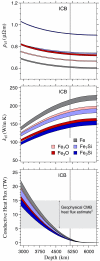Electrical resistivity and thermal conductivity of liquid Fe alloys at high P and T, and heat flux in Earth's core
- PMID: 22375035
- PMCID: PMC3306690
- DOI: 10.1073/pnas.1111841109
Electrical resistivity and thermal conductivity of liquid Fe alloys at high P and T, and heat flux in Earth's core
Abstract
Earth's magnetic field is sustained by magnetohydrodynamic convection within the metallic liquid core. In a thermally advecting core, the fraction of heat available to drive the geodynamo is reduced by heat conducted along the core geotherm, which depends sensitively on the thermal conductivity of liquid iron and its alloys with candidate light elements. The thermal conductivity for Earth's core is very poorly constrained, with current estimates based on a set of scaling relations that were not previously tested at high pressures. We perform first-principles electronic structure computations to determine the thermal conductivity and electrical resistivity for Fe, Fe-Si, and Fe-O liquid alloys. Computed resistivity agrees very well with existing shock compression measurements and shows strong dependence on light element concentration and type. Thermal conductivity at pressure and temperature conditions characteristic of Earth's core is higher than previous extrapolations. Conductive heat flux near the core-mantle boundary is comparable to estimates of the total heat flux from the core but decreases with depth, so that thermally driven flow would be constrained to greater depths in the absence of an inner core.
Conflict of interest statement
The authors declare no conflict of interest.
Figures



References
-
- Buffett BA, Huppert H, Lister JR, Woods AW. Analytical model for the solidification of the Earth’s core. Nature. 1992;356:329–331.
-
- Glatzmaier GA, Coe RS, Hongre L, Roberts PH. The role of the Earth’s mantle in controlling the frequency of geomagnetic reversals. Nature. 1999;401:995–890.
-
- Gubbins D, Alfé D, Masters G, Price GD, Gillan MJ. Can the Earth’s dynamo run on heat alone? Geophys J Int. 2003;155:609–622.
-
- Nimmo F. Thermal and compositional evolution of the core. In: Stevenson DJ, editor. Treatise of Geophysics. Vol 9: Evolution of the Earth. Amsterdam: Elsevier; 2007. pp. 217–241.
-
- Lay T, Hernlund J, Buffett BA. Core-mantle boundary heat flow. Nat Geosci. 2008;1:25–32.
Publication types
LinkOut - more resources
Full Text Sources

